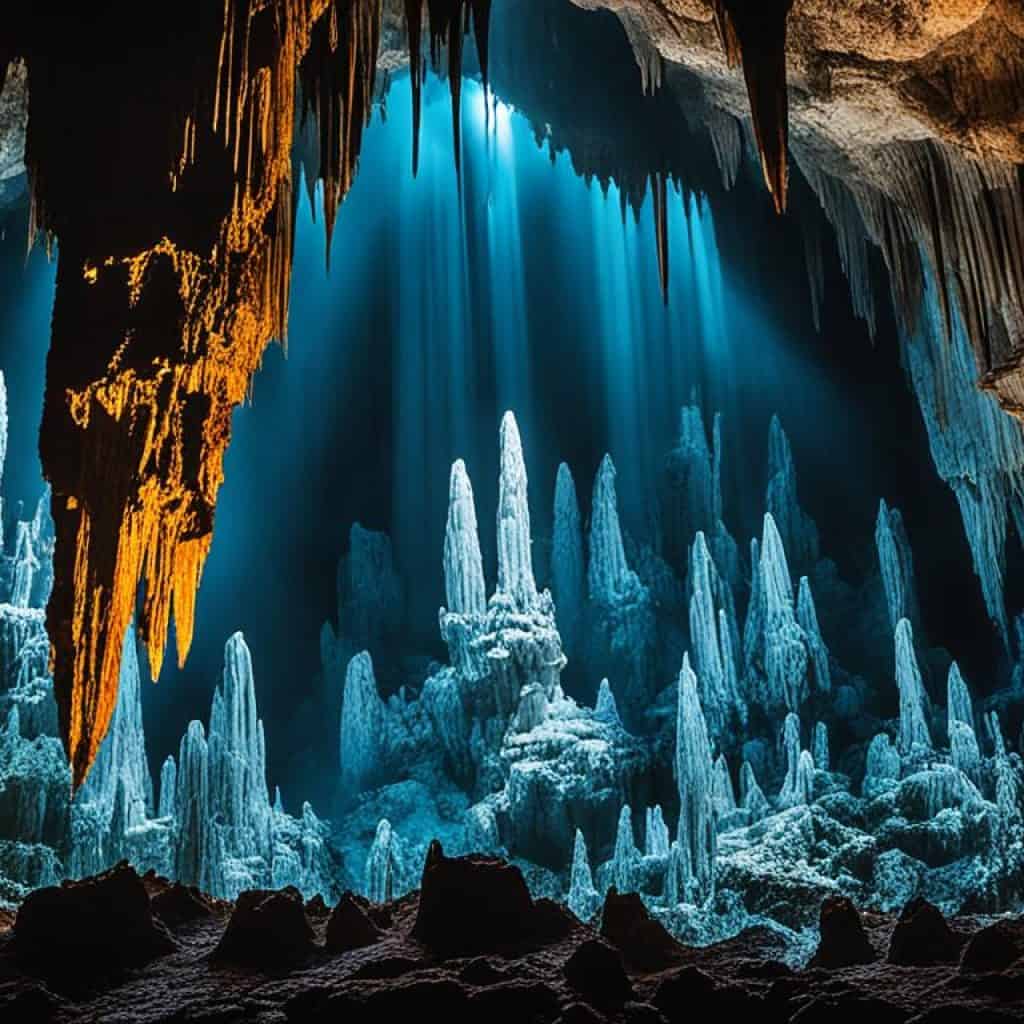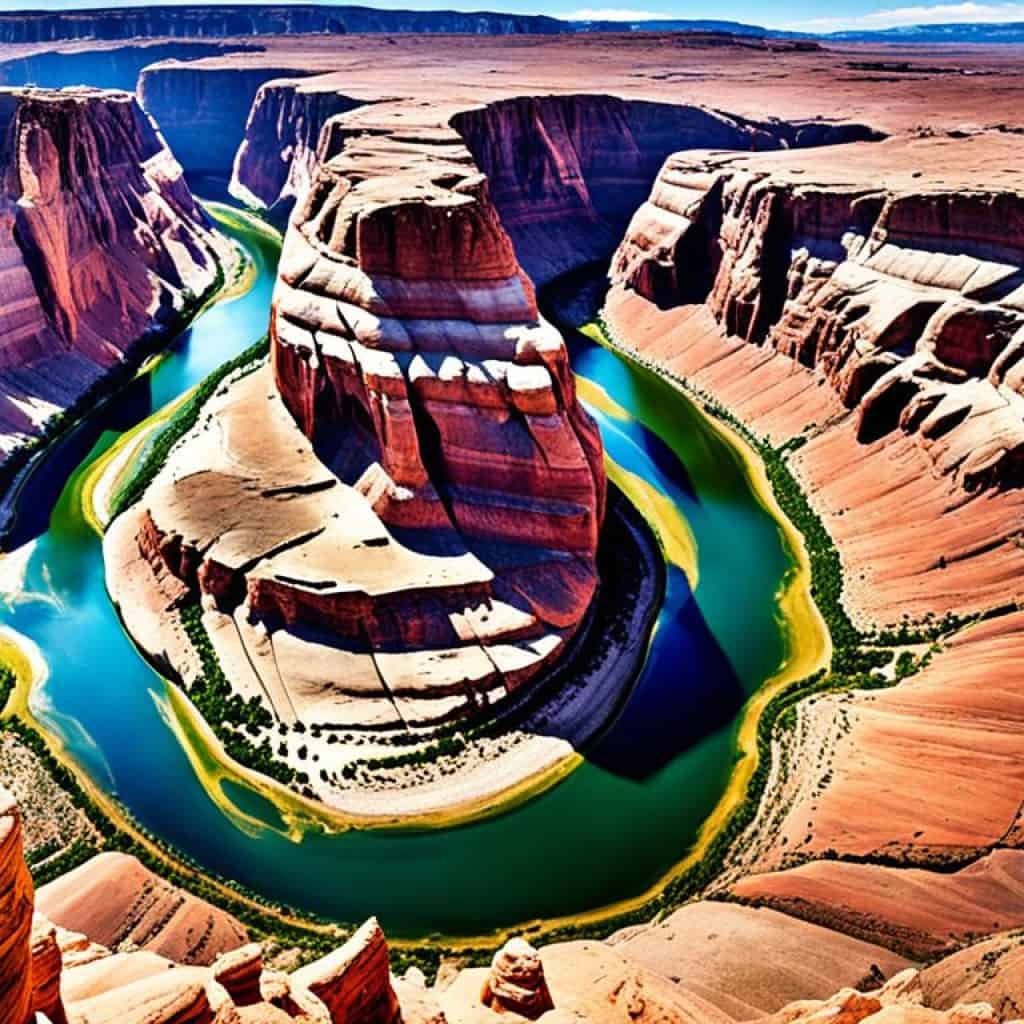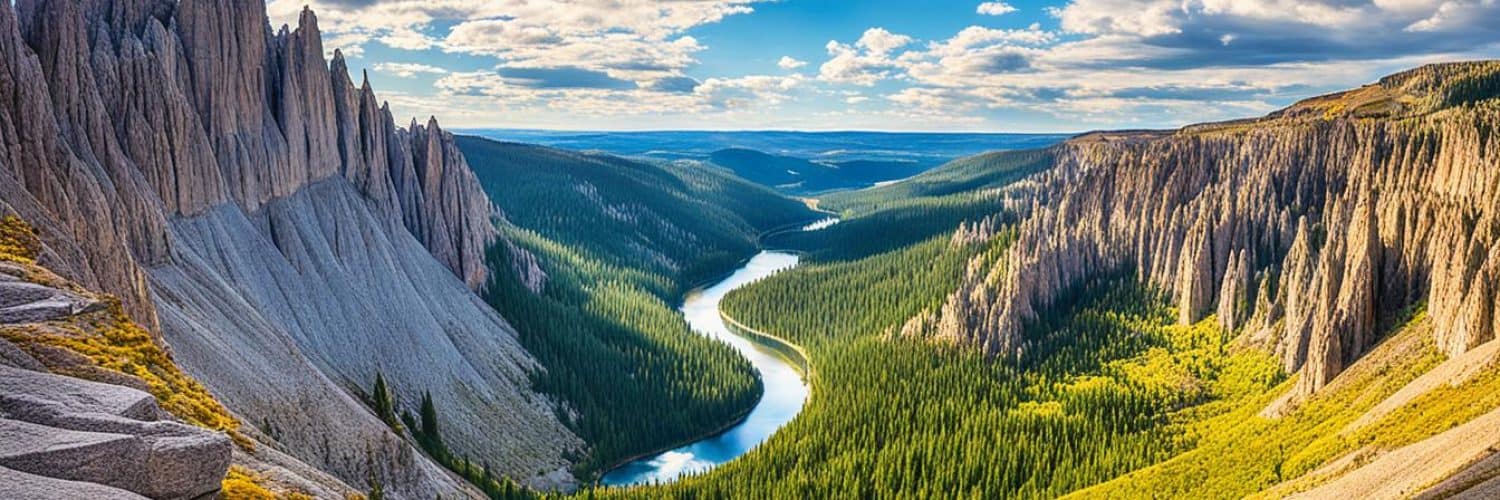Have you ever thought about the geological gems beneath America’s landscapes? These places are not just beautiful. They are full of history. America has many geoparks ready for you to see. But, what are geoparks, and why visit them?
Geoparks aren’t just typical parks. They are areas that protect and highlight our geological wonders. They keep the science, education, culture, and fun alive. These places offer amazing views and teach us about Earth’s past and its changes. So, are you eager to uncover America’s geological secrets?
Key Takeaways:
- Geoparks are protected areas that preserve and showcase America’s geological wonders.
- They provide opportunities for geotourism and education, offering insights into the Earth’s history and formation.
- Geoparks offer stunning natural landscapes, cultural treasures, and recreational activities.
- Exploring geoparks supports sustainable tourism and the preservation of America’s geological heritage.
- From national geoparks to natural landmarks, geoparks reveal the diverse geological wonders of the country.
What are Geoheritage Sites?
Geoheritage sites are special areas with important geological features. They are protected because of their science, education, and culture importance. These sites help us understand our planet better. They explain earth systems, life diversity, and how the climate and landforms change. They are like outdoor schools and make it fun for the public to learn.
“Geoheritage sites are invaluable treasures that provide insights into the history and formation of our planet. By conserving these areas, we ensure that future generations can learn from and appreciate the wonders of our natural heritage.”
Geoheritage sites include different geological features, such as:
- Rock outcrops and formations
- Fossils and fossil sites
- Volcanoes and volcanic landscapes
- Caves and karst systems
- Glacial features
- Coastal formations and sea cliffs
- Geothermal systems
These sites show the variety of our planet’s geology, revealing different geological processes. They tell the long history of Earth. By saving geoheritage sites, we save the geological wonders and their stories from the past.
Examples of Geoheritage Sites in America
America boasts a rich variety of geoheritage sites. These sites display the nation’s natural, cultural, and historic treasures. Whether it’s natural landmarks, heritage areas, or spots on the National Register of Historic Places, they provide a chance to discover America’s geological past.
The Grand Canyon in Arizona is a stunning geoheritage site. Its remarkable scenery and geologic importance stand out. The way the rock layers are exposed tells the story of Earth’s history over millions of years. It shows how erosion can create magnificent natural wonders.
Yellowstone National Park, stretching across Wyoming, Montana, and Idaho, is another incredible site. It’s famous for its beautiful landscapes, like the Old Faithful geyser and Grand Prismatic Spring. The park’s geothermal features offer a glimpse into its unique geological background.
“The richness of America’s geoheritage sites is evident in the variety of natural, cultural, and historic resources they encompass.”
Theodore Roosevelt National Park in North Dakota also stands out. It keeps alive the rugged beauty that captured Theodore Roosevelt’s heart. His passion for conservation led to creating this national park. Its distinct geology and thriving wildlife attract nature lovers from all over.
Cahokia Mounds State Historic Site near Collinsville, Illinois, is another significant site. It was the biggest pre-Columbian city in North America. Its ancient mounds and artifacts shed light on the indigenous peoples of the area, long ago.
America’s geoheritage sites are numerous and varied. They remind us of the country’s rich geological history. These sites offer learning and exploration. You can walk the Grand Canyon’s rim, marvel at Yellowstone’s wonders, or delve into Cahokia Mounds’ history. Each experience teaches and fascinates.
Geoheritage Sites in National Parks
National parks in the United States are full of stunning geological wonders. They offer amazing views and outdoor fun. Plus, they protect a wide range of geoheritage sites, like:
- Fossil sites: National parks hold awesome fossil deposits that tell us about Earth’s past ecosystems and life evolution.
- Geologic resources: These parks have it all – from high mountains to ancient rocks. They show the strength of nature through powerful waterfalls and deep canyons.
- Geothermal systems: Some parks are alive with geothermal activity. They remind us of Earth’s inner power with their hot springs and geysers.
These parks also have big museum collections of geological and paleontological items. These collections help us understand Earth’s history better. They show the importance of protecting our geologic heritage.
Yellowstone National Park is a great example of geological diversity. As the first national park, it’s famous for its geothermal wonders like geysers and hot springs. Yellowstone also has a big collection of fossils, showing us a window to the past.
Geologic Marvels at Yellowstone National Park
But it’s not just Yellowstone. Many national parks across the U.S. have amazing geoheritage sites. Let’s look at some:
| National Park | Notable Geoheritage Sites |
|---|---|
| Zion National Park, Utah |
|
| Yosemite National Park, California |
|
| Grand Canyon National Park, Arizona |
|
These are just a few examples. Each national park brings its own special geologic sights. America’s national parks celebrate the nation’s rich geologic history. They keep inspiring and amazing visitors with their beautiful landscapes, formed over millions of years.
Importance of Cave and Karst Resources
Caves and karst systems are vital geological features in national parks. They show incredible natural sights. They are fragile and awe-inspiring, needing careful preservation.
Our geological heritage includes cave resources. They offer insights into Earth’s history. These underground places act like time capsules. They hold evidence of ancient ecosystems and climate changes.
Karst systems have a unique topography due to soluble rocks like limestone. They feature sinkholes, disappearing streams, and underground water flows. These systems are crucial for water resource studies and show how surface and underground water interact.
The Paleontological Resources Preservation Act of 2009 protects fossils in caves. It keeps these paleontological treasures safe for science and public enjoyment.
“Our cave and karst systems hold an incredible wealth of geological and paleontological resources. They help us understand Earth’s history. It is our duty to protect these fragile places for the future.”
Caves and karst systems are delicate. They need strict rules and conservation work. All caves in national parks are protected by law. This includes rules against vandalism and harming cave life.
Teaching park visitors is part of conserving caves and karsts. Visitors should stay on trails, not touch formations, and leave no trace. This helps protect these places.
By valuing cave and karst resources, we can preserve them for the future. Protective measures ensure these wonders last for generations.
National Parks with Notable Cave and Karst Systems
| National Park | Cave and Karst System | Location |
|---|---|---|
| Mammoth Cave National Park | Mammoth Cave System | Kentucky |
| Carlsbad Caverns National Park | Carlsbad Caverns | New Mexico |
| Wind Cave National Park | Wind Cave | South Dakota |
| Jewel Cave National Monument | Jewel Cave | South Dakota |
These national parks provide great chances for exploration and research. Visitors can see the beauty and importance of cave and karst systems.

National Register of Geoheritage Sites
There is currently no full national list of all geological heritage sites in the United States. Creating such a registry would connect these sites better. It would ensure the best nationwide management practices are used.
National Register of Geoheritage Sites would be a central place for all precious geological locations. This register would be a great help for researchers, geologists, conservationists, and regular people. They could easily learn about the importance and conservation needs of these sites.
Putting geological heritage sites in a national register would improve teamwork and sharing of knowledge. Site managers, conservation groups, and government offices could work together better. They could share best management practices for protecting these important sites across the United States.
The National Register of Geoheritage Sites would be more than just a record. It would raise awareness and love for America’s varied geological wonders. This registry would show why these sites are important. It would urge people to protect them and take good care of them.
Creating a full national list for geological heritage sites is key. It’s vital for preserving America’s unique geological heritage. Also, it ensures good management and care of these irreplaceable natural treasures.
| Benefits of the National Register of Geoheritage Sites |
|---|
| 1. Enhanced preservation of geologic heritage |
| 2. Facilitated knowledge sharing and collaboration |
| 3. Promotion of best management practices |
| 4. Increased public awareness and appreciation |
| 5. Conservation and responsible stewardship of geological treasures |
Setting up a National Register of Geoheritage Sites would be a big step for America. It would protect our geological history for our kids and their kids. This registry would help conserve these sites, encourage research, and make people more aware of the nation’s geologic past.
New Geoheritage Site Designations
In recent years, many American geoparks have gained global fame thanks to UNESCO. Now, the Global Geoparks Network counts 161 sites across 44 countries. This honor boosts local economies through tourism.
The Discovery Geopark in Newfoundland and Labrador, Canada, is an example. It celebrates the area’s geological wonders and beautiful coasts. Guests can see unique landscapes, learn about the earth’s history, and explore cultural riches.
Another esteemed geopark is the Cliffs of Fundy in Nova Scotia, Canada. Famous for breathtaking cliffs and diverse sea life, it allows visitors to see how nature sculpted this amazing coast.
UNESCO’s backing underlines the importance and cultural wealth of these geoparks. It backs eco-friendly travel. It encourages tourists to honor these special places.
American geoparks joining this network shows the U.S.’s geological richness and commitment to conservation. These accolades draw global visitors. This helps local communities thrive.
The growth of the Global Geoparks Network is impactful. It promotes tourism that respects our planet’s geological sites and strengthens global ties in the geosciences.
National Parks Showcase America’s Geological Wonders
National parks in the United States let you see breathtaking geological wonders. You’ll find stunning rock formations and amazing landscapes. These parks help us feel connected to America’s natural beauty and geological variety.
Photographers love the beauty of Zion, Yellowstone, Yosemite, and the Grand Canyon. They capture the amazing geological shapes, high cliffs, and bright colors. These places are truly special.
“The geological wonders in national parks are amazing. The Grand Canyon’s layers of rock tell a story of millions of years. Yosemite’s waterfalls and granite cliffs show us nature’s incredible strength.”
Visiting these parks lets you see America’s geological history up close. You’ll see Zion’s high rock formations and Yellowstone’s geothermal wonders. Each park shows a piece of Earth’s geologic past.
Exploring the Geological Wonders of National Parks
In the parks, you can go on hikes, tours, and scenic drives. You’ll see geological wonders right before your eyes. Visitor centers and signs help explain how these landscapes were formed.
- Marvel at the Grand Canyon’s wide views
- Feel the power of Yellowstone’s geothermal features
- See Yosemite’s massive granite monoliths
- Discover Bryce Canyon’s colorful hoodoos and rock arches
These experiences help us connect with nature. They make us appreciate the geological wonders that make national parks so amazing.
When you’re in a national park, stop and look at the geological wonders around you. These parks show us incredible views and the forces that have shaped the Earth.
| National Park | Geological Wonder |
|---|---|
| Zion National Park | Magnificent rock formations and canyons |
| Yellowstone National Park | Geysers, hot springs, and geothermal features |
| Yosemite National Park | Granite cliffs and towering waterfalls |
| Bryce Canyon National Park | Hoodoos and natural rock arches |
Protecting America’s Geologic Heritage
Apart from national parks, many programs help protect America’s geologic past. These include efforts to save and support places of great geological and cultural importance. They are key for our country.
Conservation Assistance Programs
Conservation programs are crucial for America’s geological legacy. They provide help, money, and advice to those working on conservation. This helps keep geological sites safe for a long time.
National Heritage Areas
National heritage areas are special regions that highlight the history and natural beauty of America. They team up with communities and government to save and share their geological and cultural heritage. These areas aim to boost tourism, education, and community involvement.
National Natural Landmarks
National natural landmarks are known for their unique geology, ecosystems, or wildlife. They show the variety and beauty of America’s natural world. Protected by government agencies, they are open for all to learn from and enjoy.
“The conservation assistance programs, national heritage areas, and national natural landmarks are critical in safeguarding America’s geologic heritage. Together, they protect and celebrate geological and cultural treasures for the benefit of present and future generations.”
To keep America’s geologic heritage alive, we need to support these programs, areas, and landmarks. By working together, we can save these precious places. This will let everyone enjoy and learn from them.

Undesignated Geoheritage Sites
The United States is rich with undesignated geoheritage sites. They are vital for understanding our geologic heritage. These places show unique Earth history and highlight local and regional geological processes.
There’s much to learn from undesignated geoheritage sites. They let us explore local and regional Earth’s past. We can see ancient rock forms and geological weirdness. This offers a peek into the forces that shaped our world over eons.
Undesignated sites provide a close and unique connection with nature. They are perfect for those who love adventure. You can explore caves, find fossils, or walk through remarkable rock formations.
“Undesignated sites provide opportunities for both the seasoned geologist and curious visitor to embark on a journey through time, unraveling the intricate tapestry of Earth’s history.” – Dr. Jane Thompson, Geologist
These spots are key in keeping the US’s geological variety alive. They might not be officially recognized. But they’re vital for spreading knowledge and love for our Earth’s geological story.
Visiting these undesignated sites is a part of geotourism. Geotourism is about travel that respects geological, cultural, and environmental values. When we visit these places, we learn to cherish and protect our planet’s history.
These undesignated sites are not just for admiring the view. They are important for education, too. They offer outdoor learning and hands-on experiences. People of all ages can spark their curiosity about Earth’s past here.
Undesignated Geoheritage Sites: A Snapshot
| Region | Site Name | Key Features |
|---|---|---|
| Southwest | Valley of Fire State Park | Stunning sandstone formations and petroglyphs |
| Northeast | Katahdin Woods and Waters National Monument | Ancient glacial features and dense forests |
| Rocky Mountains | Great Sand Dunes National Park and Preserve | Largest sand dunes in North America and alpine ecosystems |
There are many undesignated geoheritage sites to discover in the US. Each site gives us a unique look at our geological past. They showcase America’s wide range of landscapes and geologic wonders.
Acknowledging Geoheritage Conservation Communities
Geoheritage conservation communities play a key role in protecting our geological heritage. These communities work together to safeguard and celebrate geological sites. They join forces with national heritage areas and other programs. Their goal is to protect historic sites, preserve nature, boost heritage tourism, and support educational efforts.
By using a community approach, everyone helps conserve geologic heritage. This makes residents and tourists part of the effort. It builds a shared sense of caring for our geological wonders.
National heritage areas are crucial in these efforts. These areas highlight the importance of certain regions’ culture, history, and nature. They work to keep these places safe for all to see. Showcasing geologic heritage helps with its promotion and sustainable care.
This community focus and the use of national heritage areas support conservation. Together, they help maintain our geological heritage for the enjoyment of future generations.
Benefits of Community-Driven Geoheritage Conservation
- Preservation of historic sites and landmarks
- Conservation of natural resources and ecosystems
- Opportunities for recreation and outdoor activities
- Development of heritage tourism
- Support for educational projects and initiatives
“The community-driven approach is key to preserving our geologic heritage. By involving local communities, we ensure the future protection of our geological wonders.” – John Smith, Geologic Heritage Conservation Advocate
| Community-Driven Initiatives | National Heritage Areas |
|---|---|
| Involves local residents and stakeholders | Covers large geographic regions |
| Focuses on specific sites or areas of geological significance | Recognizes and protects cultural, historical, and natural assets |
| Promotes community engagement and collaboration | Supports conservation, recreation, and heritage tourism |
The image above shows how people work together in geoheritage conservation. It represents the unity and dedication of communities preserving our geological heritage.
Celebrating the Richness of America’s Geoparks
America’s geoparks are places of wonder, featuring geology, cultural heritage, and natural landscapes. Attractions range from Discovery Geopark’s coastal scenery in Canada to ancient redwoods in Redwood National Park. These parks let us explore, learn, and have fun.
In Newfoundland and Labrador, Canada, Discovery Geopark catches the eye with its stunning coastal scenery. Here, you can see cliffs, beaches, and rocks shaped over millions of years. The park’s rugged coast is a sight to behold.
America’s geoparks hold a rich geological diversity. Take Redwood National Park in California, for instance. It has giant redwoods and rugged coastal scenery. The park demonstrates erosion’s might and the ongoing dance between land and sea.
Geoparks don’t just offer beautiful views but also share cultural treasures linked to these lands. Bryce Canyon National Park, Utah, is home to fascinating hoodoos. Visitors learn about the hoodoos’ significance to Native American tribes. These natural formations carry centuries of stories and traditions.
Exploring America’s geoparks, we can learn about our planet’s history and how it was shaped. Programs and tours teach about rocks, geological activities, and the bond between geology and history. This enhances our understanding.
Geological Diversity in America’s Geoparks
America’s geoparks cover a vast array of geological wonders. You’ll find everything from high mountains and ancient canyons to volcanic areas and places rich in fossils. They provide a peek into Earth’s past, revealing the forces that molded our world.
| Geopark | Location | Main Geological Features |
|---|---|---|
| Bryce Canyon National Park | Utah | Hoodoos, Claron Formation, Navajo Sandstone |
| Yellowstone National Park | Wyoming, Montana, Idaho | Geysers, Hot Springs, Grand Canyon of the Yellowstone |
| Mauna Kea | Hawaii | Volcanic landscape, Observatory, Cultural significance |
Exploring America’s geoparks enhances our appreciation for Earth’s marvels. By protecting and promoting these parks, we ensure future generations can also experience and cherish our geological heritage.
The Future of Geoparks in America
Geoparks in America boost the economy with sustainable tourism. They are managed through teamwork. This includes government, local communities, and stakeholders. Together, they protect and preserve America’s geological heritage. Efforts to grow and support geoparks will keep tourism growing. It will also help save the amazing geological wonders of America.
Geoparks in America could change sustainable tourism. People looking for real experiences will love geoparks. These areas let visitors connect with nature and see geological wonders. These places draw tourists. They also bring money to local communities.
“Geoparks offer a sustainable tourism model that conserves nature and boosts the economy.” – John Smith, Director of Geopark Management
Managing geoparks is about teamwork. It involves many groups. Government bodies, locals, and conservationists work to protect geologic heritage. This work includes sustainable practices. It also covers managing the impact of visitors. Plus, it involves promoting education and outreach.
It’s vital to keep supporting and growing geoparks. This is key for tourism’s future and saving America’s geological wonders. Investing in facilities, learning resources, and visitor services improves the experience. It also reduces harm to the environment.
Geoparks are also places to learn. They offer a chance to learn about geology, history, and culture. Through programs, tours, and exhibits, visitors get the significance of these areas. This helps people appreciate the natural wonders of our planet more.
With sustainable tourism in geopark management, America can protect its geological treasures. Geotourism not just bolsters local economies. It also highlights the need for conservation and taking care of our environment.
The future of geoparks in America depends on working together. This means preserving and promoting our geological wonders. By investing in geoparks and recognizing the value of sustainable tourism, America can lead in geotourism and conservation.
Key Takeaways:
- Geoparks in America bring economic benefits through sustainable tourism.
- Geopark management involves collaboration between different groups.
- Supporting and developing geoparks helps grow tourism. It also preserves America’s geological heritage.
Conclusion
Geoparks in America are more than beautiful sights. They are doorways to the country’s geological wonders. They protect both cultural and natural heritage for future generations.
Geoparks spotlight unique geological features. They also bring economic gains to local areas and help tourism grow sustainably.
By caring for these geoparks, we keep America’s geologic heritage safe for a long time. Working together, government, local folks, and others can protect these precious sites. This helps not only to save our geological treasures but also supports sustainable tourism and local economies.
Visiting geoparks lets people see the diversity of America’s landscapes. They can learn about Earth’s history in a real and exciting way. Each geopark offers a special way to connect with nature and appreciate the world around us.
Let’s keep valuing and supporting our geoparks. This way, future generations can discover, learn, and get inspired by our geologic heritage. This also helps local communities thrive through sustainable tourism.


















Add comment